During the 17 days China Yangtze River Cruise tour, you will first visit some majestic palaces in Beijing. After that, you will visit the Terracotta Army that guards the first emperor of China for millenniums in Xi’an. In Lhasa, the westernmost destination of your Yangtze River cruise China tour to Tibet, you can feel how pious the Tibetan Buddhist believers are in seeing the temple covered with gold. During your China tour with Yangtze River Cruise and panda visit, you will meet chubby pandas in Chengdu and travel along the Yangtze River to see the majesty of the Three Gorges and feel the inspiration of human beings by visiting the Three Gorges Dam. At the last stop of your tour, Shanghai, a city that combines history and modernization, you can catch a glimpse of the development of China in the recent hundreds of years. Book this Yangtze River Cruise Tour with Lhasa and start your exploration of China!

Welcome to the capital of China, Beijing. Your China tour with the Yangtze River Cruise will start from this millenniums-old city. A population of more than 20 million, which is nearly equal to the population of Australia, inhabits Beijing, making it one of the most populated cities in the world.
Upon your arrival, your guide will be waiting for you at the airport with your name sign in hand. Then, your guide will take you to the hotel and help you check in.
After breakfast, your exploration of Beijing will begin with visiting Tian’anmen Square, one of the most sacred places for Chinese people. Covering over 400,000 square meters, it is the largest city square in the world. Located in the center of this city, Tian’anmen Square served as a place to issue important government decrees and hold grand celebrations when it was first built in the Ming Dynasty (1368-1644). In 1949, it witnessed the founding of the People’s Republic of China. After that, many military parades and grand gatherings have been held here. At the northern end of Tian’anmen Square stands the Tian’anmen Gate Tower, where you can enter the Forbidden City. There are five gates in the gate tower. In ancient times, people must observe strict rules when they passed the gates. The one in the center was for the emperor only; the outer two were for other royal members and high-ranking officials; the outmost two gates were for lower-ranking officials and other people. Anyone who broke the rules would face severe punishment. Yet exceptions existed. The emperor’s parents had the privilege to enter the Forbidden City through the central gate, so did the newly married empress. The empress could only do that for once.
After finishing your sightseeing on Tian’anmen Square, you will enter the Forbidden City (closed each Monday). Covering 720,000 square meters, it is around five times larger than Buckingham Palace in Britain. As the royal palace of the Ming (1368 -1644) and Qing (1636 -1912) dynasties for over 500 years, it was the center of power in ancient China. Today, as a museum, there are nearly one million pieces of precious collections in it, including paintings, ceramics, calligraphy works, musical instruments, jade wares, and so on. Walking within the Forbidden City, you can see hall after hall, room after room. It is said that it contains 9999 and a half rooms. You may be curious about the number. Why not 10,000 rooms? According to the Chinese legend, the emperor was the son of the Heavenly God, and the latter owns 10,000 rooms in heaven. As the son, the emperor should possess fewer rooms than his father.
After lunch, you will visit the Summer Palace. Built in 1750, it was an imperial garden in the Qing Dynasty. The Summer Palace covers over 3 square kilometers, with the water area that covers over three quarters. The Summer Palace consists of palaces, rockeries, bridges, pavilions, corridors, and so on. All of them are elaborately constructed. One famous attraction in the garden is the Marble Boat that lies northwest of Kunming Lake. It was far more than a view in the imperial garden. The Marble Boat was placed here as a warning sign to the emperor. There is an old saying in China, “The water that can carry a boat also can overturn it.” That means, if the emperor cares for his people, he can enjoy long-term peaceful governance. But if he fails to perform his duties, the people will rise and overthrow him. So, the Marble Boat was used to admonish the emperor that he should take care of his country and his people.


The first place you are going to explore today is the Temple of Heaven, where the emperors of the Ming and Qing dynasties attended sacrificial ceremonies and prayed for good harvests. Covering nearly 3 square kilometers, it is the largest building complex for worshiping heaven in the world. The north part of the wall surrounding the Temple of Heaven stretches in an arc shape, while the south part of the wall stretches in a square shape. This design reflects the conception of ancient Chinese people that heaven was round and the ground was square. The main buildings in the Temple of Heaven, including the Circular Mound Altar, the Hall of Prayer for Good Harvests, and the Imperial Heavenly Vault, are all designed based on this conception.
After that, you will go to Old Beijing Hutong, where ordinary Beijingers have lived for generations. You will take a rickshaw to visit the old Hutong. Besides, a family visit to one of the quadrangle dwellings, the centuries-old folk houses of Beijing, is an unforgettable experience for tourists. Today, your guide will take you to one of the quadrangle dwellings, where you can have face-to-face communications with local residents living in the Hutong. They will share stories about their lives of living in the Hutong with you. Sometimes you may even encounter residents whose ancestors were imperial guards or imperial chefs. In that case, they may tell you some anecdotes in the Forbidden City in detail.
After lunch, you will visit Mutianyu Great Wall, the longest and best-preserved part of the Great Wall. Located 70 kilometers northeast of Beijing, it takes around one and a half hours by car. In ancient times, the nomadic tribes in the north invaded central China and plundered the people there from time to time. To protect the territory and the people from the northern invasion, the Great Wall began to be built. But the project was enormous and laborious. Millions of people gave their lives to build the Great Wall. According to the Chinese folklore, in the Qin Dynasty (221 BC-207 BC), a woman named Meng Jiangnv came to the Great Wall in the hope of finding her husband who was conscripted to build the Great Wall years before. When she knew her husband had died and got buried under the Great Wall, she was heartbroken and burst into tears. She cried beside the wall for three days and nights. Suddenly, the stretch of the wall in front of her collapsed. The body of her husband was uncovered. This story tells us the Great Wall was built by the greatest ordinary people with extremely huge sacrifices.
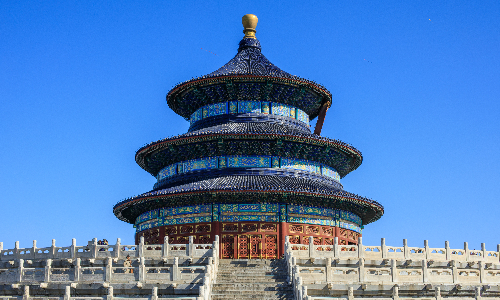
 Xi’an
Xi’an It is time to say goodbye to Beijing and set out for another millenniums-old city – Xi’an, the second stop of your Yangtze River Cruise tour. After breakfast, you will check out and head to the train station. You will take the estimated train G571 09:22/15:06 to Xi’an. As a famous historical city, Xi’an has a history of more than 3,000 years. It has served as the capital of 13 dynasties for over 1,000 years. Together with Rome in Italy, Cairo in Egypt, and Athens in Greece, Xi’an is one of the four ancient capitals in the world. And it was also the eastern terminus of the Silk Road.
This morning, you will explore Terracotta Warriors and Horses Museum after breakfast. The museum is 40 kilometers northeast of Xi’an, and it will take nearly one hour to get there. Inside the Terracotta Warriors and Horses Museum stands the magnificent Terracotta Army that has been guarding the mausoleum of the first emperor of China, Ying Zheng, for over 2,200 years. There are over 7,000 terracotta warriors and horses, as well as more than 100 chariots in the museum. Each of the terracotta warriors is the same size as a real man. The warriors are vivid and lifelike, with their expressions different from one another. In 1998, when the former president of the United States, Bill Clinton, visited the museum, he was amazed by the craftsmanship of the terracotta warriors and horses, and he asked whether he could purchase a terracotta warrior. His request placed the director of the museum in a difficult position. The Terracotta Warriors and Horses are invaluable treasures of the Chinese nation. It is impossible to sell them for money. But refusing the request would embarrass President Clinton. At last, a staff member of the museum came up with an ideal solution. He made a terracotta warrior with the earth of the relic and presented it to Mr. Clinton as a gift.
After lunch, you will visit Big Wild Goose Pagoda, a pagoda built over 1,400 years ago that has become one of the emblems of Xi’an. In 645, Monk Xuan Zang, one of the most eminent monks in Chinese history, came back to China from India with lots of precious Buddhist scriptures, statues of Buddha, and Buddhist relics. Approving the proposal of Monk Xuan Zang, the government built the Big Wild Goose Pagoda in 652, where Monk Xuan Zang could store the Buddhist treasures he had brought back and translate the scriptures. As a landmark since it was built, the pagoda has been highly valued. People who newly became successful candidates in the highest imperial examination had the privilege to write down poems and signed their names on the pagoda in the Tang Dynasty (618 -907), which was one of the highest honors for them.
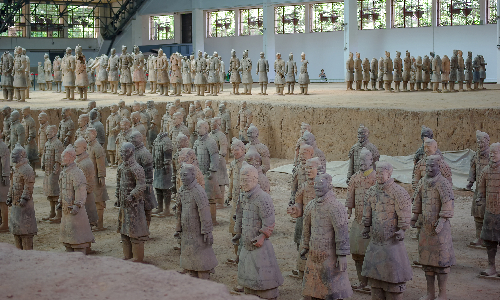

 Lhasa
Lhasa This morning, you will take the estimated flight HO5666 11:10/14:25 to Lhasa, the provincial capital of Tibet with the highest altitude in the world. The weather here is always sunny, so it is called “the City of Sunlight”. As the center of Tibetan Buddhism, Lhasa attracts thousands of pilgrims every year. When you arrive in Lhasa, your guide will be at the airport to pick you up and take you to the hotel. It is advisable to have a good rest at the hotel this afternoon, for the average altitude of Lhasa City is over 3,600 meters, a height that might cause altitude sickness, especially for newcomers. Don’t do strenuous exercises because of the thin air.
Today, the first attraction you will explore is Potala Palace, the building complex with the highest altitude (about 3700 meters above sea level) that serves as a palace, castle, and temple at the same time. It was built in the 7th century by Songtsen Gampo, the king of the Tubo Kingdom (633-842), for marrying Princess Wencheng, a niece of Emperor Li Shimin of the Tang Dynasty. Potala Palace covers 410,000 square meters. Built along the slope of the majestic Red Hill, it is not only beautiful but also luxurious. The pagoda built for the 5th Dalai Lama in the palace is wrapped with gold and decorated with a variety of precious jewels, which cost over 110,000 taels (about 4,100 kilograms) of gold. It is said that it cost more than 30 tons of gold to decorate the Potala Palace.
After lunch, you will visit another holy land of Buddhism, the Jokhang Temple. Located in the center of this city, Jokhang Temple was built in 647 by Songtsen Gampo to worship the full-size statue of Sakyamuni at the age of eight. The statue was brought by Princess Bhrikuti of Nepal from her motherland when she married Songtsen Gampo. The legend goes that the location of the temple was primitively a vast lake. One day, Songtsen Gampo strolled along the lake with Princess Bhrikuti. He showed a ring to the princess and said, “I will build a temple for you and the Buddha at the place where the ring falls.” Then, he threw the ring into the sky and the ring fell into the lake. At that moment, the lake began to shine and a white pagoda rose slowly in the light. Later, Songtsen Gampo built a temple with the white pagoda at its center. That temple is the Jokhang Temple we see today.
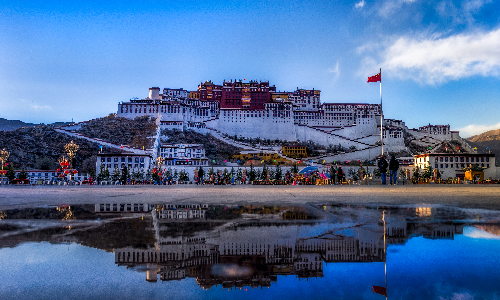
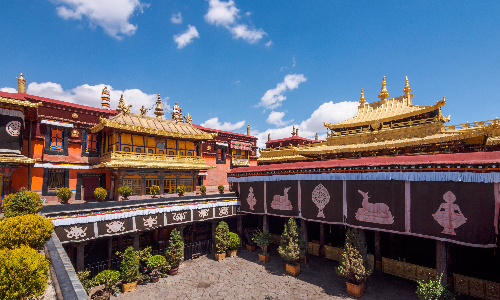
After breakfast, you will go to Norbulingka, the summer palace of the Dalai Lama. It was built in the 1740s by the 7th Dalai Lama. Covering 360,000 square meters, it contains elaborate buildings and over 100 kinds of plants, including many precious flowers unique in Tibet. On the walls of the New Palace, the latest palace built by the 14th Dalai Lama in Norbulingka, there are vivid serial pictures that show the brief history of Tibet, including the origin of Tibet, the rise and fall of the Tubo Kingdom from 633 to 842, the struggle between different Buddhist sects from 846 to 1391, the birth of the first Dalai Lama in 1391, and stories after that.
Then, you will visit Drepung Monastery, the largest monastery in Tibet. “Drepung” means “an accumulation of rice” in Tibetan, a symbol of prosperity. Built along the mountain, the complex of white buildings is just like a heap of rice when looking from afar. Constructed in 1416, it is the most important monastery for the Gelug Sect of Tibetan Buddhism. Of all the numerous ceremonies held here every year, the ceremony during the annual Shoton Festival is the grandest one. During the Shoton Festival, a giant thangka – a painting of the Buddha will be displayed at Drepung Monastery. Pious Buddhists from all corners of Tibet will come here to worship the giant thangka, which is over 1,000 square meters.
After lunch, you will pay a visit to Sera Monastery, which was built from 1419 to 1434. In its heyday, it accommodated over 8,000 monks living and studying Buddhism. The most significant activity in this monastery is the Buddhist Scripture Debate. For the monks, debating over Buddhist scriptures is an indispensable method to learn Buddhist doctrines. The debate usually takes place between two opposite groups of monks. Sometimes several monks in one group will challenge the only one in another. The monks ought to have some insight into the Buddhist scriptures and at the same time, be quick-thinking and articulate to perform well in the debate. Before being accredited as a Geshe Lharampa − the highest academic degree of Tibetan Buddhism, one must pass the Buddhist Scripture Debate exam.


 Chengdu
Chengdu This morning, you will leave Lhasa and take the estimated flight 3U8694 11:45/13:40 to another city − Chengdu, the provincial capital of Sichuan Province. Chengdu is called the “Land of Abundance” because of its favorable climate, high agricultural output, and rich natural and cultural resources. As the fourth stop of your Yangtze River tour, you will encounter majestic sculptures, lovely pandas, and delicious foods here.
The first place you will explore in Chengdu is Chengdu People’s Park. Built in 1911, the park covers over 110,000 square meters. There are many views in it, including a meandering rivulet, an artificial lake, a memorial square, several gardens, and two rockeries. Below the Eastern Rockery lies an air-raid shelter that was built in 1965. After a renovation in recent years, it has been opened by the government to the public for enjoying the cool in summer. The temperature in the shelter remains around 26℃ (about 78℉), even though the temperature outside is more than 10℃ (50℉) higher. When sheltering in it, people can also learn Chinese history and culture from the pictures on the walls.
After that, you will visit the Kuan Zhai Alley, which was built in 1718. Strolling along Kuan Zhai Alley, you can see centuries-old folk houses and taste a variety of local delicacies. One delicious delicacy you can taste in the street is the “Heartbroken Bean Jelly”. You may be confused by the name. The name comes for two reasons. Firstly, the bean jelly is both delicious and spicy. When eating the bean jelly, one may burst into tears because it’s pungently spicy. If a person passes by, he would mistakenly think the person must be heartbroken for tears running down his face. Secondly, its name also shows Sichuan people’s love for their hometown. If a Sichuan person is far away from home and has a taste of this delicacy, this familiar and delicious food will make him or her homesick and tearful. So don’t be tricked by the name of the food. Just have a try, and you will discover that it is very yummy.
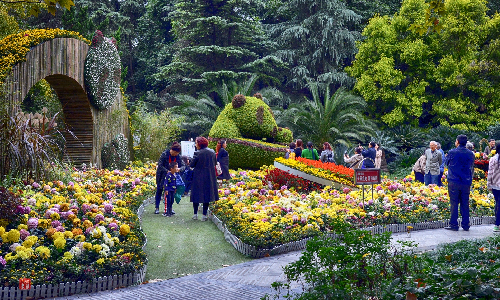

After breakfast, you will travel around 160 kilometers south to visit Leshan Giant Buddha. The journey will take about two hours. Leshan Giant Buddha is the largest sculpture of Buddha in the world. Completed in 803 in the Tang Dynasty, the giant Buddha is 71 meters high. A single instep of the giant Buddha can accommodate over 100 people to sit side by side on it. The giant Buddha was built to protect local people’s well-being. The giant Buddha is beside the confluence of three rivers, namely, Minjiang River, Dadu River, and Qingyi River. Before the giant Buddha was built, the water here was quite turbulent with a strong undercurrent. Boat accidents always happened and many people were drowned every year. People built the giant Buddha by chiseling the stone mountain at the confluence. The rubble that fell from the mountain dropped into the river, making the river much less turbulent by blocking the undercurrent. Since then, there has been a decrease in boat accidents and drowning incidents.
On your way back to Chengdu, you will visit Huanglongxi Ancient Town, which lies between the Leshan Giant Buddha and Chengdu downtown. The ancient town is around 120 kilometers north to the giant Buddha and it will take 1.5 hours to transfer to the town. Huanglongxi Ancient Town has a history of over 1,700 years. There are many well-preserved centuries-old buildings in it, as well as six millennium-old banyan trees. The town is also one of the few towns in China that keep sounding the night watches. In ancient times, without an advanced timer, people relied on the patrol’s sounding to know the time. Today, local residents of the town no longer depend on this way to know the accurate time, but they still cherish this tradition that has been passed down from generation to generation.

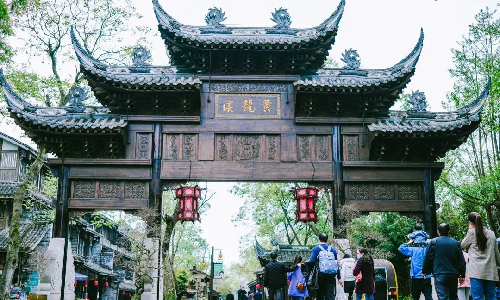
 Chongqing
Chongqing Do you still remember the secret panda village in the Hollywood movie Kungfu Panda 3, where hundreds of pandas inhabit? This morning, you will explore the panda village in real life, where over 200 pandas live and breed − Chengdu Research Base of Giant Panda Breeding. Do you know why pandas are black and white? Legendary goes that the ancestors of pandas were once white, just as polar bears. One day, they got captured by a group of cheetahs. Four girls saw what had happened and decided to fight the cheetahs to rescue the pandas. Finally, they helped the pandas out of danger at the cost of their lives. The pandas were so sad that they began to cry. Their tears mixed with the black sand under their feet and some parts of their bodies were dyed black. From then on, pandas became white and black. Don’t you think the pandas in black and white look more adorable than all-white pandas?
This afternoon, you will leave Chengdu for Chongqing by taking the estimated train G2887 15:07/16:32. When you arrive in Chongqing, your guide will be waiting for you at the railway station. After that, your guide will take you to Chaotianmen Wharf, which is around 20 kilometers northeast to Chongqing West Railway Station, and it will take about 30 minutes by car. Your Yangtze River Cruise tour will start from here. The guide will help you check in. Then, you will travel along the Yangtze River by yourself. The cruise ship sets sail at 21:00. Anyone who takes the cruise is supposed to get on board before 20:30.


This is the first morning you spend on the Yangtze River. You can stay in bed until you have enough sleep. The breakfast the cruise ship offers is a buffet meal. You can choose Chinese food or Western food as you like. After that, you can go to the deck, where reading a book, having a cup of coffee, or viewing the riverside landscapes will be pleasant. If you want to do some exercise in the morning, follow the teacher on the board to learn Tai Chi, a traditional Chinese shadow boxing. After experiencing all the amazing things in the past few days, you may have a deeper understanding of nature, culture, or life. You can write down your thoughts. In the future, when you see these words, they will bring you memories of your Yangtze River Cruise tour in China.
Today there will be a shore excursion. You will visit Shibaozhai Pagoda, which is on a small island. The pagoda is more than four hundred years old. Built along a hillside, the red pagoda with a height of 56 meters looks majestic against the green background of the hill. Surround by a giant dike, it looks like a large-scale bonsai on the Yangtze River, known as one of the top eight fantastic buildings in the world.
Besides, there is an optional shore excursion at Fengdu “Ghost City”, which needs extra payment. At Fengdu “Ghost City”, you will have a thrilling and unforgettable experience. You will catch a glimpse of a complete netherworld with ancient Chinese people’s conception.
The lunch today will be a buffet. In the evening, the captain will host a welcome dinner for guests.
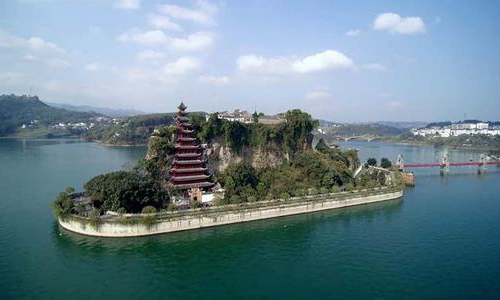
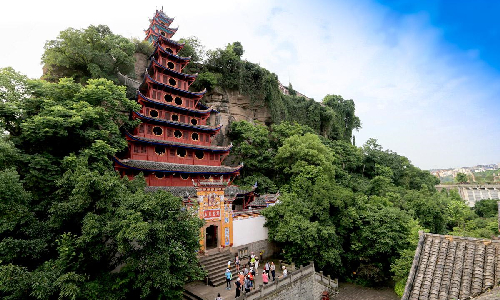
After having a buffet meal for breakfast, you can practice Tai Chi for morning exercise. Maybe you will find you have made much more progress than before. Today the cruise ship will pass through the Three Gorges − Qutang Gorge, Wu Gorge, and Xiling Gorge. Here, you can enjoy the magnificence of the mountains along the Yangtze River. At Wu Gorge, you will take a small boat to visit the Goddess Stream. The Goddess Stream is named after the Goddess Peak beside it. According to a Chinese legend, in ancient times, people living along the Yangtze River suffered from severe flood disasters every year. Goddess Yaoji helped to dredge the river and then turned herself into a peak to supervise the river and guard the local people. It is the Goddess Peak. Cruising on the Goddess Stream, you can see how much the peak looks like a goddess. Tonight, the captain will host a farewell dinner for the guests and there will be a wonderful crew cabaret as well.
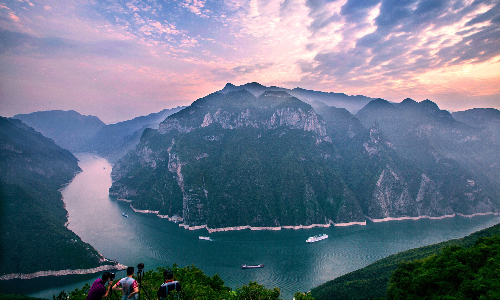

 Shanghai
Shanghai Today, you will have a shore excursion to visit the Three Gorges Dams Site. As the biggest dam in the world, it is 3,335 meters long and 185 meters high. Because of the dam, the annual carrying capacity of the Yangtze River for shipping improved from 10 million tons to 50 million tons. Everyone gets shocked when seeing the immensity of the dam. You could also pay extra fees to experience the additional shore excursion – boarding a sightseeing ferry to sail through the Three Gorges Dam Ship’s elevator. In less than twenty minutes, a 3000-ton ship can be elevated 113 meters vertically by the elevator.
After sightseeing at the Three Gorges Dams Site, you will be transferred to Yichang Three Gorges Center Cruise Terminal. On your arrival at the terminal, your guide will be there to pick you up. Then, you will be taken to Yichang East Railway Station to take the estimated train D354 14:46/22:21 to Shanghai, the last stop of your China tour including the Yangtze River Cruise. As a city that combines history and modernization, Shanghai has a history of over 2,500 years, which can date back to the Spring and Autumn Period (770-476 BC). Meanwhile, it is the economic, financial, and trade center and the largest city of China.
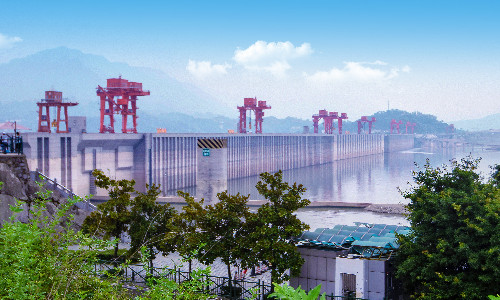

After breakfast, you will visit Yu Garden (closed each Monday), which was built more than 400 years ago. Covering over 20,000 square meters, the garden consists of halls, bridges, corridors, centuries-old trees, and so on. The garden was built by a high-ranking official of the Ming Dynasty for his parents. The name “Yu” means “peace” in Chinese. The official wanted his parents to live peacefully and contently in this garden. Sadly, both of his parents passed away before the garden was completed. Yet, the filial piety of the official passed generation after generation. There is a ginkgo tree that was planted by the official personally when building the garden. Standing before the tree that was over 400 years old, you can catch a glimpse of his love for his parents.
Then you can reach the next resort, Shanghai Old Street, which is very close to Yu Garden. The street is 825 meters long from west to east. Walking along the street, you can see not only ancient architecture but also century-old brands. It is also a paradise for shopping. You can buy some souvenirs there. The paper-cut works in the street are exquisite. The history of paper-cutting can date back to the 6th century. With just a pair of scissors and a piece of red paper, a papercutting craftsman can create any pattern in his mind, whether it is a Chinese character, a tiger, or a peony.
After lunch, you will visit the Oriental Pearl TV Tower, a landmark of Shanghai. The tower is located at the bank of the Huangpu River, the last tributary of the Yangtze River before it enters the sea. The tower was opened to the public in 1995, and it is the sixth-highest tower in the world with a height of 468 meters. There are three sightseeing floors in it. The highest one, known as the Space Capsule, is 351 meters high. The main sightseeing floor – Sightseeing Galleria is 263 meters high. Boarding the Sightseeing Galleria, you can have a panoramic view of the city.
After that, your guide will take you to Nanjing Road. Stretching around 5 kilometers, Nanjing Road is one of the busiest commercial streets in Shanghai. It became the first commercial street after the Shanghai Port was opened in 1843. In the street lies the Grand Theatre that was built in 1928. Jointly built by Chinese businessman Gao Yongqing and Albert Warner, a co-founder of Warner Bros. Entertainment, Inc., the theater is known as the “No.1 Theater in the Far East”. It was the first theater in Asia with an air-conditioning system, and the first one to show talkies and dubbed films.
Then, you will explore the Bund, which once belonged to French and British concessions. Europeans, especially the French and the British built a lot of European buildings when they were there. Known as the exotic building cluster of Shanghai, British classical architecture, Italian Renaissance architecture, Baroque architecture, and Gothic architecture can be seen here. The No. 18 building on the Bund, built in 1923, was once the headquarters of Standard Chartered China. Four ancient Greek marble columns of the building primitively belonged to the Tuscani Church in Italy over 200 years ago. Now, this building is a consumption center for fashion, jewelry, art, and delicacy.
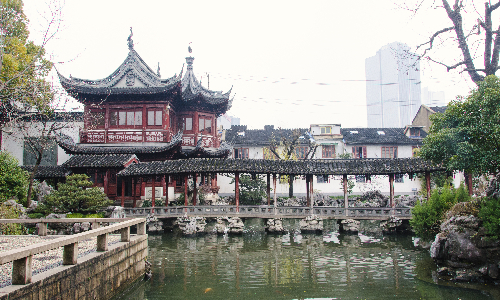
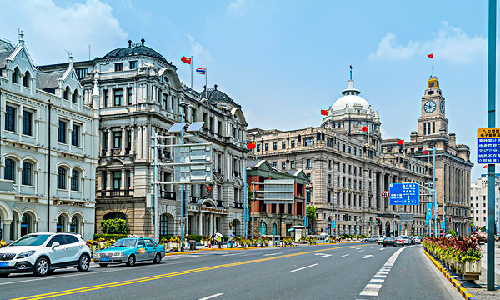
After breakfast, you will visit Shanghai Museum (closed each Monday). Covering 11,000 square meters, the museum contains nearly 1 million pieces of collection, including ancient bronze wares, jade wares, paintings, ceramics, sculptures, calligraphy works, and so on. One famous collection is a bronze ware named Da Ke Ding (a bronze food vessel) that is 93 centimeters high and weighs 201.5 kilograms. It was made over 2,500 years ago. In 1890, this bronze vessel was unearthed and soon purchased by Pan Zhuyin, a wealthy art connoisseur. During the Second World War, descendants of Pan Zhuyin buried it in their backyard to prevent it from being plundered by the enemy. In 1951, they donated it to Shanghai Museum.
The next place you will explore is Jade Buddha Temple. Located in the downtown of Shanghai, it is called a serene land in the busy metropolis. The temple is named after the jade Buddha sculpture in it. The jade Buddha sculpture, made by carving a whole piece of jade, is 1.95 meters high in a sitting posture. In 1882, Monk Huigen traveled from the southeast of China to the southwest of China on foot. Then, he continued his pilgrimage toward the west on foot until he finally reached the homeland of Buddha, India. On his way back home, he encountered a piece of giant jade in Myanmar. He decided to turn the jade into a Buddha scripture. With the help of overseas Chinese, the magnificent jade Buddha scripture was finally made and brought to China in 1899.
After lunch, you will be driven for about one hour and twenty minutes to Zhujiajiao Ancient Water Town, around 50 kilometers southwest of Shanghai. In the town, there are lots of ancient architectures, including architectures of the Ming and Qing dynasties and that of the Republic of China era (1912 -1949). The well-known North Street (also known as “A Strip of Street”) has a history of over 400 years. As the best-preserved ancient street of the Ming and Qing Dynasties in Shanghai, the street is more than 300 meters long. With two-story buildings standing side by side along the street, the narrowest stretch of it is only 2 meters wide. Walking along the street, you will see the sky over your head is as thin as a strip.
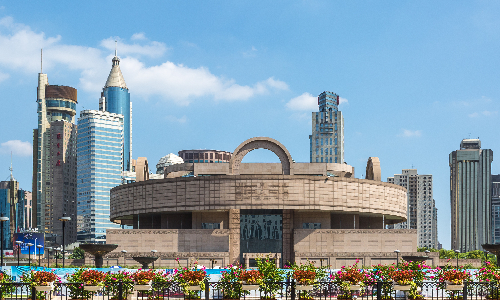
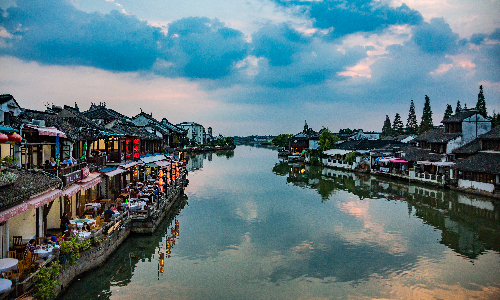
It’s time to say goodbye to China. Your guide will accompany you to the airport and help you check in. It has been our privilege to share these days with you. Wish you all the best!
Author: Lu Hai
Proofreader: Vivian Zhou
| City | Five Star hotel list | Four Star hotel list |
|---|---|---|
| Beijing | Sunworld Dynasty Hotel Beijing Wangfujing | Sunworld Hotel Wangfujing |
| Xi'an | Tianyu Gloria Grand Hotel Xi'an | Sunworld Dynasty Hotel |
| Lhasa | Shangri-La Hotel Lhasa | Thangka hotel |
| Chengdu | Sofitel Chengdu Taihe | Holiday Inn Express Chengdu Jinniu |
| Yangtze River Cruise | Victoria Anna | Victoria Anna |
| Shanghai | Ocean Hotel Shanghai | Courtyard by Marriott Shanghai Central |
 |
![]() About your child or infant, please contact us for a discounted price.
About your child or infant, please contact us for a discounted price.



We started with a few days in Beijing & ended in Shanghai, from where we visited the Forbidden City and Great Wall. In between we visited Terra Cotta Warriors Museum, Panda Base, Shanghai Disneyland.

We had a wonderful holiday in China which will remain long in the memory. China is a breathtakingly beautiful country full of splendid temples and palaces, mountains and rivers, peaceful rural scenes and bustling shopping streets.
 QUICK ENQUIRY
QUICK ENQUIRY